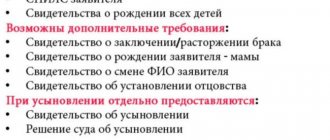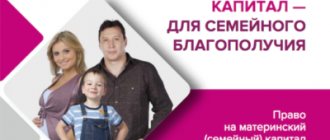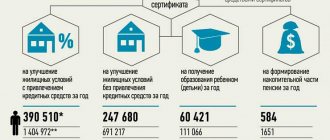Maternity pension is not an option for many
According to statistics, only 2% of recipients send maternity capital into retirement.
This category mainly includes those families who do not need to improve their living conditions or spend certificate funds on other purposes. Parents often believe that this money will either dissolve in our pension system or be eaten up by inflation, since the Russian Pension Fund rates cannot cope with the real rise in prices. Therefore, the “maternity capital” program and the pension, which can be formed from these funds, have not yet worked at full capacity in this connection. However, experts say that some women purposefully direct their maternity capital towards retirement in order to live carefree in old age. Of course, the amount for “carefree” is small, but it is more profitable than frozen money that the family may never need for other needs. After all, sending a certificate for a mother’s pension has a number of undeniable advantages.
About the program and its conditions
Since 2006, in connection with the adoption of Federal Law No. 256-FZ of December 29, 2006, the federal program of maternity (parental) capital began to operate, the main purpose of which was to provide a decent life for Russian citizens and support motherhood.
According to the terms of this program, since 2007, residents of the Russian Federation, upon adoption or birth of a second or subsequent children in a family, have the right to receive a certain payment from federal budget funds.
Initially, in 2007, the amount of such payment was set at 250,000 rubles. Every year its size was indexed and in 2020 it amounted to 466,617 rubles.
The funds received under the maternal certificate can be used for certain purposes established by law, and subject to certain restrictions.
- The funds received can be used in the following areas:
- improvement of living conditions;
- payment for future education of children;
- increasing the level of pension, in other words, the opportunity to use all or only part of maternity capital for the mother’s pension;
- providing families raising disabled people with the opportunity to create conditions for their integration into society and the purchase of certain goods and services.
- The program establishes a direct ban on cashing out money using a certificate. Therefore, payments under it are made by transferring non-cash funds to the address of the home seller, credit institution, educational institution.
- It is possible to spend maternity capital only when the child reaches the age of three. An exception is the case when funds are used to pay off parental loan obligations received when purchasing housing or improving living conditions.
The law does not establish any restrictions or deadlines during which certificates must be used, in other words, papers already received can be used at any time.
Certificates not used before 2020 were indexed annually by the state, which made it possible to significantly increase the amount of payments.
Benefits and changes for 2020
Despite the fact that disposing of funds in favor of the mother’s future pension is not very popular in the Russian Federation, this direction still has its advantages:
- The mother's old-age pension is increasing.
- There is a possibility of increasing your pension through investment income.
- There is an opportunity to increase the compensation received for child care time.
- Possibility of using funds for other purposes.
The amount of payments under the maternal certificate in 2020 increased by 3.1%. It has been established that the amount will be 466,617 rubles or 616,617 rubles if the second child was born in 2020.
Pros and cons of transferring funds to form a pension
The funds can be used to form your future pension, and more specifically, its funded part. But you need to take into account that the amount received is not transferred immediately after the birth of the child, but only after reaching the age of three .
However, there are a number of exceptions when maternity capital funds can be used before the child reaches the age of 3 years.
The law provides for the distribution of funds received from maternity capital in different options for calculating pension payments.
There are several advantages of transferring money to your mother's pension:
- the amount of payments for old age will increase ;
- the amount of maternity capital will increase due to investment income generated from the turnover of funds;
- Women are not paid insurance contributions during maternity leave, so investing in a pension fully compensates for losses.
The investment is beneficial for the mother; it will help ensure financial independence in old age .
For mothers, the insurance period includes only maternity leave for up to 1.5 years. If a mother decides to devote herself to a child before the age of three, then she loses three years of work experience.
The insurance pension in our state consists of two parts.
- Insurance. Calculated based on length of service, points are added.
- Cumulative. It is formed from payments based on insurance premiums. Voluntary contributions are welcome to help increase it.
It is possible to independently increase the size of your pension by transferring “capital” funds to the funded part. There are pros and cons everywhere, just like in this system. The main disadvantage that scares our population away from such actions is the unguaranteed indexation of funds . Money from capital may depreciate over time, leaving the pension at a low level.
But you don't need to think only about the bad. There are many advantages to such an investment:
- in the event of the premature death of the owner of the capital, all saved funds are transferred to the heirs , in this case they are only the father and child;
- The insurer has the right to manage its own future pension and can select favorable investment conditions.
You should not immediately abandon such investments; you need to think about further actions.
Composition of pension
There are several types of pension insurance in Russia:
- non-state;
- state.
In this case, the pension of each person consists of the following indicators:
- The insurance part, which is formed based on the amount of insurance experience, as well as pension points. In other words, depending on the length of service and the amount of accruals made by the employer for the period of employment of the citizen.
- The savings part, which is formed voluntarily. Its size can increase due to government funding, or due to the maternal certificate. However, there are the following disadvantages:
- there is no guarantee that the amounts will be indexed;
- there is a possibility of losses.
The advantage of the savings part is the possibility of its inheritance. If it is formed at the expense of maternal capital, the heirs in this case can be the father (adoptive parent) of the child, who is a minor himself.
3. Voluntary part, the size of which is formed through independent contributions of the person. According to the law, for each amount of money contributed, the state undertakes to contribute the same amount of its own. The doubling rule applies only if the total amount deposited per year is 2,000 rubles. Voluntary contributions are allowed to be made by persons whose year of birth is 1966 or later.
If maternity capital is contributed to the funded part of the pension, its size will be significantly increased, and it is possible to calculate the future amount to be received now.
Not all holders of a maternity certificate use funds to increase their pensions and trust this method of investment. The size of the state payment is constantly changing, but by replenishing it with maternity capital, this amount can be significantly multiplied.
Funds allocated to the funded part of the mother’s pension can be withdrawn at any time and used for other purposes. But this must be done before the pension payments are assigned.
Current legislation does not prohibit the registration of maternity capital in the name of the father (adoptive parent) of the child. He can spend targeted funds in the same way as his mother, with the exception of the desire to use them to form his future pension. This is due to the fact that the named program was developed primarily to support women on maternity leave during the period from one and a half to three years of the child - this time is not included in the total insurance period.
How much will your pension increase using maternity capital funds?
The result of directing maternity capital funds to form the funded part of the mother’s pension will be known only after the woman actually retires. To know the approximate profit of an investment, it is necessary to carry out a calculation .
Example
For example, a woman born in 1992 decided to use MSC funds to form her future pension in 2020. The amount of maternity capital was not indexed after 2020; in 2019, the size of the certificate is 453,026 rubles . A woman will be able to retire when she reaches 60 years of age, that is, in 2052. Accordingly, for 33 years , the funds allocated for the formation of a funded pension will be increased at the expense of the selected pension fund.
For example, the profitability of a management company for the year is 5.75%. Thus, the amount of pension savings will be:
453,026 x (1 + 5.75%)33 = 2,866,656 rubles
Depending on the type of payment, the increase in the mother’s pension will be:
- unlimited term (21 years) - 2,866,656/252 months = 11,375.62 rubles ;
- fixed-term (10 years) - 2,866,656/120 months = 23,888.8 rubles .
Since the profitability of management companies can change every year, the obtained values are approximate.
Reasons why money is transferred to the mother's pension
It is known that maternity capital cannot be cashed out. You can receive a small part of the amount in “real” money. But this is the exception rather than the rule. State statistics are kept on the areas of intended use. Thanks to it, we know that of the 5 million families who fully spent the certificate funds, more than 90 percent improved their living conditions.
Of those who received the certificate, only 4 thousand submitted documents and applications for transfer to their mother’s funded pension. The reasons that pushed them to take this step are the following:
- Receiving a decent pension even without work experience. For example, in large families, where the mother, most often, does not have the opportunity to work.
- The opportunity to influence the size of your pension.
- The funded part of the mother's pension will not be lost even if the mother dies. It is inherited. The condition for the succession of the funded part is death before the assignment of the labor pension. Simply put, receiving money is only possible if the savings portion has not been spent at all.
- There is an opportunity to receive a lump sum payment. What does it mean? According to the law, this innovation allows you to receive money not only monthly throughout your life, but also at one time. Not everyone has this opportunity, but only certain categories of the population, especially the disabled.
- The funded pension can be paid in urgent payments (monthly, in certain amounts).
- By investing maternity capital funds aimed at forming the funded part, the funded part of the pension grows over time.
- Indexing of the cumulative part is possible.
If family members change their minds or another pressing problem arises that can be solved using maternity capital funds, it is possible to change the use of the certificate. To return the funds, it is enough to write an application to the Pension Fund of the Russian Federation (PF RF).
✅ 4 pros and 2 cons of directing maternity capital to your mother’s retirement
Transferring maternity capital funds to pension payments has the following advantages:
- A woman gains financial independence during a period when she is deprived of the opportunity to work.
- Additional funds due to an increase in future pension can be used to receive quality medical care or purchase the necessary medications.
- The funded pension is inherited: if the owner of the certificate dies, the money will be inherited by the children and husband.
- The woman retains the opportunity to change the direction of spending the certificate.
The disadvantages of transferring maternity capital to the mother's pension are:
- High risks of depreciation of maternity capital by the time the mother retires. In this case, investing in real estate or education can provide greater returns.
- Regular changes in the pension system reduce confidence in it among citizens.
How it works
Let's try to find out how profitable it is to invest maternity capital in a future pension? It should be taken into account that not everyone who has received a certificate needs to improve their living conditions or allocate money for their children’s education. Funds can be sent to the Pension Fund. This may be all funds of the maternal capital or only part of it.
After the pension reform in 2002, the future pension of Russians began to be formed from three parts:
- basic;
- insurance;
- cumulative.
The size of the pension began to largely depend on how many contributions were received into the personal account of the future pensioner. The savings part can be stored in the Pension Fund and non-state pension fund (NPF). A pensioner can dispose of this part much more freely. But the insurance part of the pension cannot be transferred to a non-state fund.
The funded part of the pension can be increased at the expense of maternity capital. Let's calculate how much it can increase. Let's take the following as initial numbers:
- investments in the funded part of the pension of a share of maternity capital in the amount of 200 thousand rubles;
- Mother's retirement is due in 11 years;
- Let us assume that the return on the non-state fund chosen by the mother is 8%.
Having made the calculations, adding every year 8 percent of the investments in the funded part, we get after 11 years an amount that exceeds the original by more than 2 times - 466,327.5 rubles . Note that these figures are greater than the amount of maternity capital today. If with such an investment ( 200 thousand rubles ) it will be 20 years until retirement, then the account will have almost a million ( 932 thousand rubles ).
After retirement, you can opt for immediate payments (payment in equal installments over a certain period of time). If the application is made for 5 years, then the monthly supplement to the pension will be 7772.1 rubles per month (466,327.5: 60 months (5 years) = 7772.1).
The mother can transfer all pension savings accumulated in the account to any other fund. This can be done before reaching retirement age, 55, by filling out an application. You can transfer money no more than once a year.










